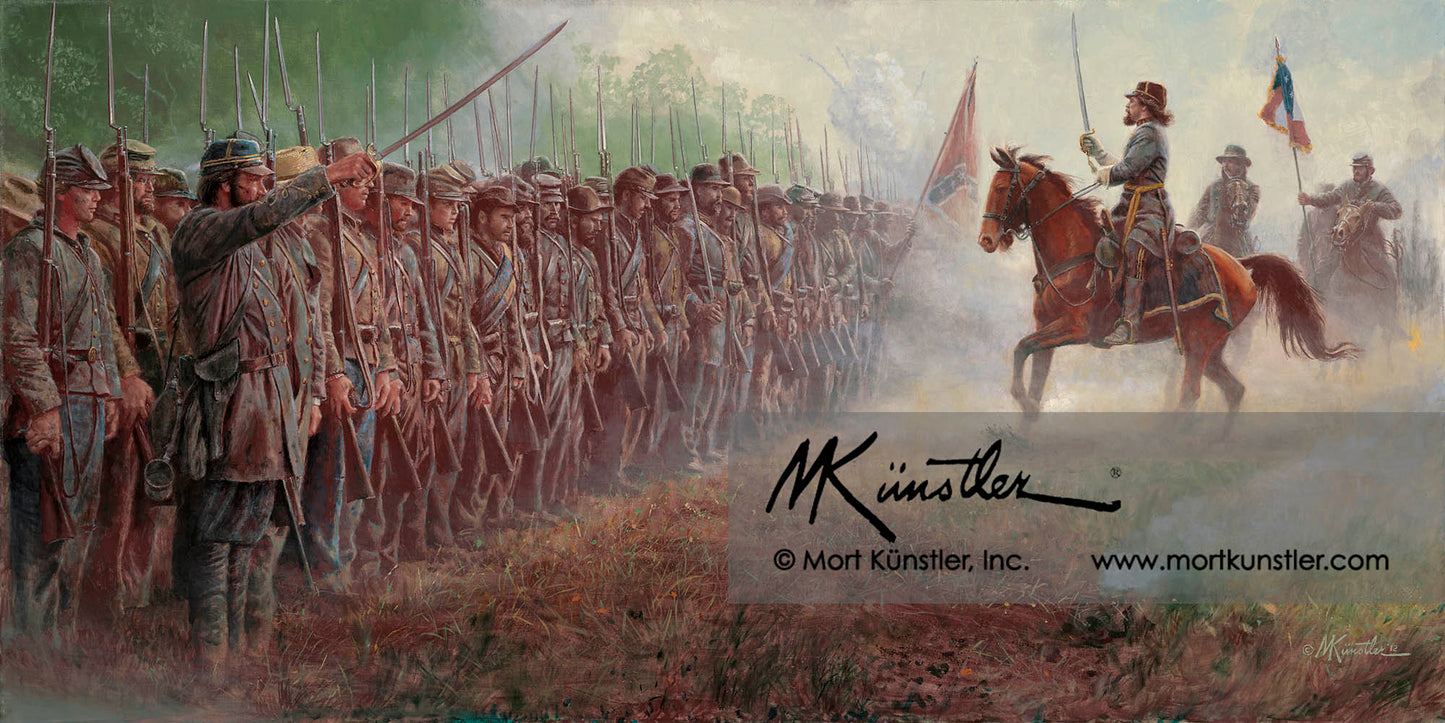The Official Mort Künstler Website
Pickett's Charge - limited edition print
Pickett's Charge - limited edition print
Gettysburg, July 3, 1863
Couldn't load pickup availability
* Free shipping within the Continental United States.
Custom framing is available for this print. Please call 800-850-1776 or email info@mortkunstler.com for more information.
LIMITED EDITION PRINTS
Paper Prints
Reproduction technique: Fine offset lithography on neutral pH archival quality paper using the finest fade-resistant inks.
Each print is numbered and signed by the artist and accompanied by a Certificate of Authenticity.
Image Size: 14-1/2” x 29” • Overall Size: 19-1/2” x 33”
Signed & Numbered • Edition Size: 350
Signed Artist’s Proof • Edition Size: 50
Giclée Canvas Prints
Reproduction technique: Giclées are printed with the finest archival pigmented inks on canvas.
Each print is numbered and signed by the artist and accompanied by a Certificate of Authenticity.
Signature Edition 14” x 28”
Signed & Numbered • Edition Size: 50
Signed Artist’s Proof • Edition Size: 10
Classic Edition 17” x 34”
Signed & Numbered • Edition Size: 50
Signed Artist’s Proof • Edition Size: 10
Premier Edition 22” x 44”
Signed & Numbered • Edition Size: 15
Signed Artist’s Proof • Edition Size: 5
Collector's Edition 29” x 58”
Signed & Numbered • Edition Size: 5
Signed Artist’s Proof • Edition Size: 2
Historical Information
As one of the most decisive engagements in one of the most renowned battles, the tragic assault known as Pickett's Charge still resonates 150 years later. After several unsuccessful attempts to envelop Federal forces, General Robert E. Lee concentrated his remaining strength of artillery and infantry at the center of the Union lines.
Despite the initial hesitation from his senior commander, Lt. General James Longstreet, Lee remained steadfast in his tactical plan, which called for nearly 12,000 men (nine brigades) to march over 1,000 yards across open ground. His confidence in the infantry's ability to reach the enemy was bolstered by the plan to precede the initial charge with a concentrated cannonade. However, an insufficient concentration of Confederate fire foiled the plan.
The brunt of the assault was borne by the infantry troops, who were required to march into the oncoming fray of Federal artillery and musket fire with virtually no available cover. The rebel troops marched deliberately in a line across the open plain, accelerating only when they were within a few hundred yards of the enemy. This line of troops, under the commands of Major General Isaac R. Trimble, Major General George E. Pickett and Brigadier General J. Johnston Pettigrew, stretched out for more than a mile. The majority would never reach their target, a copse of trees defended by troops under General Winfield S. Hancock's command.
Prior to the assault, General Pickett gallantly addressed his troops as they waited in the hot July sun. Despite the arduous task that lay before him, Pickett appeared to be in very high spirits and his confidence was infectious. Riding up and down the line, he shouted to his men that they were all Virginians and to remember what they were fighting for. With that encouragement, Pickett's men courageously stepped off into what would become one of the most fateful engagements in American military history. Suffering incredible losses, more than half of Pickett's division was killed, wounded, or captured, including all three of his brigadier generals.
The following day, Lee began to withdraw and move his army south toward the Potomac River, thus concluding the Battle of Gettysburg. The procession of wounded and receding troops stretched out for more than fourteen miles. Many Southerners later came to believe that Pickett's Charge represented the "High Water Mark" of Confederate hopes for independence.
Mort Künstler’s Comments
When the sesquicentennial of the Battle of Gettysburg approached in July, 2013, I began to think about doing a new painting commemorating that famous event. In reviewing all the previous paintings and drawings that I have done (more than twenty of Pickett's Charge alone), I realized that I had never done a full painting and print of Pickett's Charge with General Pickett in the scene. I had recorded the charge from its beginning to the end, but always with General Louis Armistead leading.
There was a sketch of Pickett with the troops that I did for the book "Gettysburg." As the official artist for the movie "Gettysburg," produced by Ron Maxwell for Ted Turner, I was asked by Turner to create as many pictures as I could within a limited time, to illustrate the book that would be a companion to the major motion picture. The new sketches that I developed, combined with existing art that I had done, resulted in more than sixty works for this project. Turner published the book in 1993 simultaneously with the grand opening of the movie at the National Theatre in Washington, D. C.
I also noted that it was the twentieth anniversary of the movie and the book. I knew then that I would show Pickett in front of the troops on horseback before the charge, using my sketch of twenty years ago as my inspiration.
Knowing the tragedy that would later befall the majority of the men depicted in this painting, it is my hope that I captured the courage and conviction of them all, as well as the enthusiasm of their fervent commander. Pickett's Charge represents both the triumph and tragedy of war that was experienced on both sides. The Confederate forces suffered an incredible defeat, while their counterparts achieved a victory that echoed the disaster they had suffered themselves just a few months before in Fredericksburg, Virginia.





